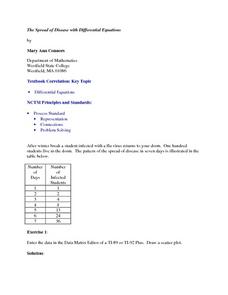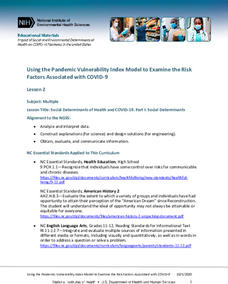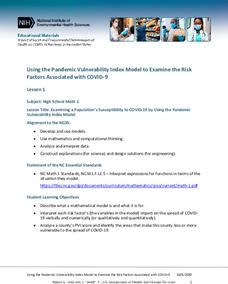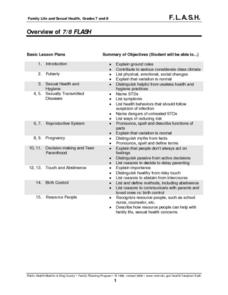Curated OER
Classify the Microbes
Young scholars classify microorganisms into categories based on their characteristics. Pupils use a taxonomic key to identify organisms. They classify certain bacteria, protists, and viruses using a classification or taxonmic key.
Curated OER
The Spread of Disease with Differential Equations
Twelfth graders solve problems using differential equations. In this Calculus lesson, 12th graders analyze data regarding the spread of a flu virus. Students use the symbolic capacity of the TI-89 to develop a model and analyze the...
Curated OER
Pandemic Panic
Students gather information about the H1N1 virus, and share this information. In this pandemic lesson students read about Influenza A, or Swine Flu, compile information on the disease, and then present their findings to the class.
King Country
Lesson 26: HIV/AIDS & Other STDs - Day 3: HIV/AIDS
The third lesson in the three-part series on HIV/AIDS and other STDs considers how these diseases are passed, how to protect against them, and risky and safe behaviors. The discussion of condom use and sexual behaviors are explicit.
Cornell University
Bacteria Take Over and Down
Bacteria outnumber all other forms of life on Earth. Scholars observe the growth of bacteria in petri dishes to understand their role in maintaining good health. Then, they observe the growth of bacteria after they introduce...
Children’s Hospital of Philadelphia
Understanding How Diseases Spread
To boost disease prevention, high schoolers arm themselves with information about infectious diseases and how they spread. Scholars research the causes, prevention techniques, and identify high-risk groups especially vulnerable to a...
Children’s Hospital of Philadelphia
Case Study: The 1918 Influenza Pandemic – Factors Beyond the Biological that Influence the Spread of Disease
A very timely instructional activity looks at the social and political factors that affect the spread of disease. Using the 1918 Influenza Pandemic as a case study, pupils research factors that influenced the spread of the disease,...
Children’s Hospital of Philadelphia
Meet the Heros
Vaccine development is the focus of a lesson plan that explores its history, timeline, and how the scientific method aids the process. Following a discussion about Edward Jenner and Small Pox, learners answer questions in their journals...
National Science Teaching Association
Why Do We All Have to Stay Home?
Learners, especially young ones, might be confused about why or frustrated that we have to stay at home. Help answer questions and calm emotions with a nine-page resource that details topics regarding the COVID-19 pandemic.
National Institute of Environmental Health Sciences
Lesson 2: Using the Pandemic Vulnerability Index Model to Examine the Risk Factors Associated with COVID-19
A lesson asks young mathematicians to investigate the social determinants and the environmental factors that influence risk factors associated with the spread of COVID-19. Class members then brainstorm what they can do to alleviate the...
National Institute of Environmental Health Sciences
Lesson 1: Using the Pandemic Vulnerability Index Model to Examine the Risk Factors Associated with COVID-19
How vulnerable are you to COVID-19? High school mathematicians use the Pandemic Vulnerability Index to create models that help them collect and analyze data about the risk factors associated with COVID-19. After investigating four groups...
Children’s Hospital of Philadelphia
Vaccine History and Research
It all becomes a matter of timing. Groups use a variety of resources to research the history of vaccines by first creating a timeline of vaccine research using leading scientists' work. Learners read articles to develop a story of the...
National Institute of Environmental Health Sciences
A Student Exploration of the Global Impacts of Climate Change on Human HealthVector-Borne Diseases
Develop an understanding of how climate change affects humans' health. The class lists what they know about climate change and its connection to disease and then read sections of an article providing specific details on how climate...
Nemours KidsHealth
Colds and Flu: Grades 9-12
Flu fighters unite! To get the word out about the importance of getting vaccinated against the flu, groups create posters that persuade teens to get immunized. Also, scholars read articles about how to cope with colds, then create...
Nemours KidsHealth
Colds and Flu: Grades 3-5
Two lessons from Kids Health Network aid in the prevention of cold and flu. The first lesson challenges scholars to read articles, discuss their findings, then create a PSA for proper prevention methods. The second lesson includes a game...
Curated OER
Myth Busters: HIV Transmission
Students discuss the facts and myths about HIV. In this health lesson, students explain how diseases spread from person to another. They create a presentation to share their research findings with the class.
Curated OER
Hector's World - Lesson Plan - Interactive Episode - Computer Security: "Oops"
Students examine the need for strong passwords when working online. In this computer password lesson, students access an animated sequence at the given web site. They determine the need for computer passwords when working on shared...
Curated OER
For the Birds
Students examine the different types of pandemic flu viruses and virus "scares" that have occurred over the past hundred years by creating a master chart that displays the origins, transmission, symptoms, and socio-historical impact of...
Curated OER
Antigens versus Antibodies "KO'd in Round Three" The Third Line of Defense of the Human Immune System
Seventh graders investigate antibodies, as the body's third line of defense against disease. They discover why antibodies do not defend the body against viruses and create a pantomime of the antibody/antigen/HIV relationship.
Curated OER
FLASH
Students Distinguish among assertive, aggressive, passive and manipulative behaviors,Describe consequences of each,Formulate an assertive request,Describe how it feels to risk rejection. Students Describe how human immunodeficiency virus...
Curated OER
Micro-Organisms
Learners investigate micro-organisms with an on line activity. In this micro-organism on line lesson plan, students identify bacteria, viruses and fungi projected onto a white board. Learners work in groups and use a computer and an on...
Curated OER
HIV/AIDS in Our Spanish-Speaking Community and the World
Students study the HIV virus and how it has impacted the hispanic community. In this infectious disease lesson students discover how HIV/Aids is found all over the world, what misconceptions are out there and what kinds of treatments...
Curated OER
Monitoring an Epidemic: Analyzing Through Graphical Displays Factors Relating to the Spread of HIV/AIDS
Tenth graders differentiate pandemic and epidemic. In this health science lesson, 10th graders analyze how HIV and AIDS affect different countries. They construct and interpret different types of graphs.
Nemours KidsHealth
Germs: Grades 9-12
Beware the bugs! Two activities engage high schoolers in the study of germs, what they are, what they do to the body, and what can be done to prevent them from spreading. After reading a series of related articles, groups create a...
Other popular searches
- Viruses and Bacteria
- Computer Viruses
- Bacteria Viruses
- Deadly Viruses
- Compare Viruses and Bacteria
- Bacteria and Viruses Biology
- Bacteria Viruses Protists
- Bacteria and Viruses Review
- Viruses and Immunity
- Biology Viruses
- Viruses and Bacteria Labs
- Viruses Cut Out

























